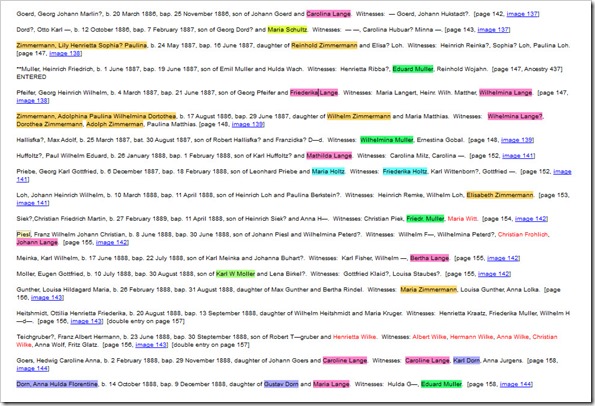Week 40 Prompt: Harvest
This week’s 52 Ancestors theme is”Harvest.” It’s that time of year, where the leaves begin to change color, the weather cools, and the fields are harvested. While I do have a good deal of farming families that experienced a fall harvest, I decided to talk about a different kind of harvest—that is data harvesting.
Several years ago, I was able to access the American church records related to one of my (many!) German brick wall families. I went through three hundred years of records (that is, one hundred years each of baptisms, marriages, and burials—four generations attended that church!). I read through each German-written entry and harvested every one where the surnames of the family and their known associates appeared (including those who appeared as witnesses to others people’s events). I collected them in a Scrivener file and color-coded each surname (see below), which helps with accounting for variants of a particular name, as I entered them as they were originally written in the record. In Scrivener, you can search by how something is formatted, which is why the color-coding technique is helpful. Instead of searching on a name (and all of its variants), I can simply search for anything highlighted in a particular color. This process of collecting all of the entries in one place allowed me to see many connections that I would not have seen otherwise. It ultimately led to the destruction of this particular brick wall.

The last eighteen months I’ve been harvesting church records for two other German brick wall families in the same manner, having found their townland in Germany. And again, I am smashing through these brick walls. There’s still more work to do on these two families, as well as the original family from years ago (I began to harvest the church records from across the pond from FHL microfilm, but with a common surname, it was a little tricky and I ran out of time on that trip back in 2014). It’s easier when the records are online and I can leisurely comb through them. Of these three families, some records are online, while others are on film and not digitized at all. It’s a time-consuming process, sometimes difficult, but it is well worth it.
Note: I know you can also search by format in Word, but I haven’t experimented with it to see if this technique would work. It’s on a list of blog post ideas to explain this technique further using Scrivener and, if it’s an option, in Word. Regardless of the search capability (which is extremely helpful), simply seeing the color-coding alone helps make connections you might otherwise miss.


Share your thoughts...